Creating a dedicated homeschool room has become a popular trend among parents seeking an organized and inspiring learning environment for their children. A well-designed space not only boosts focus and motivation but also makes daily lessons more enjoyable and efficient.
In this article, you’ll discover a variety of creative homeschool room ideas that cater to different styles, spaces, and budgets. From colorful, playful setups to sleek, minimalist designs, these ideas will help you craft a functional and inviting learning area tailored to your family’s needs and preferences.
1. Bright Magnetic Chalkboard Wall for Interactive Lessons
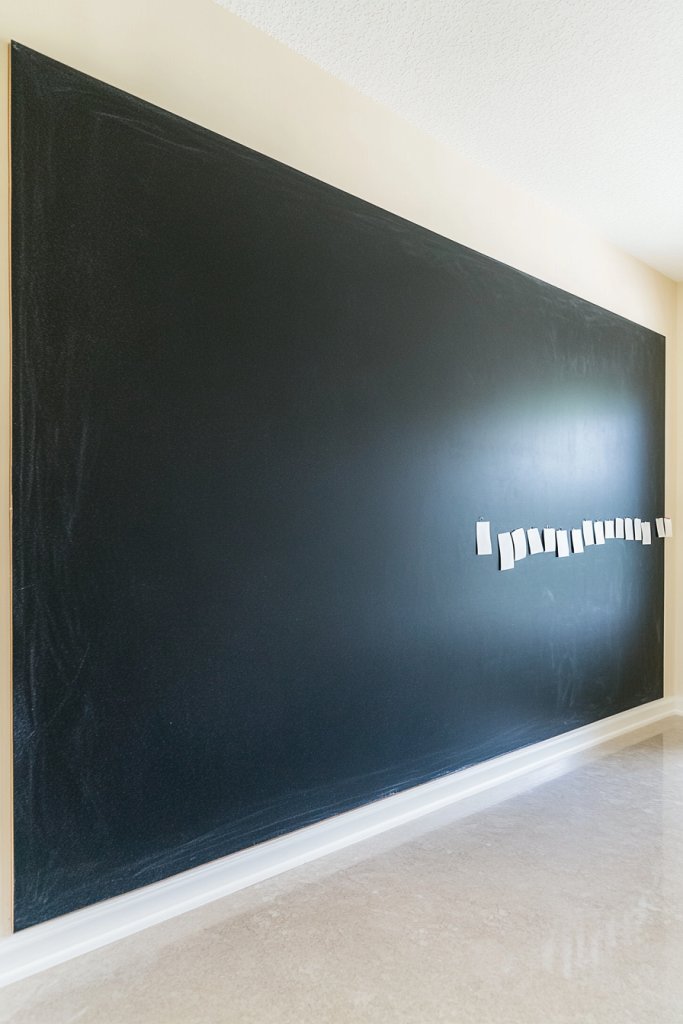
Ever tried jotting down quick notes or brainstorming ideas and wished your wall could do more than just sit there? A magnetic chalkboard wall turns a dull space into an interactive hub that sparks creativity and keeps lessons lively. It solves the headache of scattered papers and fleeting ideas, giving your homeschool a dynamic focal point.
Who wouldn’t want a space that invites spontaneous learning moments? Imagine a large wall painted with matte black chalkboard paint, dotted with colorful magnetic letters and shapes. The surface is textured just enough to feel satisfying under your fingertips, perfect for doodling or note-taking.
Adjacent to it, a tray holds chalks, erasers, and magnetic pinboards, creating a vibrant, functional scene. The space hums with activity, as ideas jump from magnetic tiles to handwritten notes with ease.
Depending on your style, you could opt for a sleek modern look with metallic trims or a rustic vibe with reclaimed wood framing. For smaller spaces, a partial wall or a large framed magnetic panel works just as well.
Seasonal themes can be added with removable decals or color schemes, keeping the area fresh and engaging. Even kids’ rooms can convert a corner into this interactive station for versatile use.
Start by selecting high-quality magnetic chalkboard paint or panels that suit your wall’s dimensions. Prepare the surface by cleaning thoroughly and priming if needed.
Apply the paint in even coats, allowing proper drying time, or mount a pre-made panel. Organize your magnetic tools and chalks in nearby containers or trays for easy access.
Consider adding a small shelf or ledge for extra supplies and decorative touches. Maintenance involves occasional cleaning and replacing worn-out chalks or magnets.
Personalize your chalkboard wall with fun borders, themed decals, or inspiring quotes in colorful vinyl. Use different colored chalks or metallic markers to highlight key ideas or lessons.
Magnetic letter sets can be customized with your child’s name or favorite words, making the space uniquely theirs. You can also add clipboards or pocket organizers for worksheets or flashcards to keep everything tidy.
A magnetic chalkboard wall transforms learning into an inviting, creative experience. It encourages kids to express themselves freely and stay engaged longer.
Seeing their ideas come to life on a dedicated surface boosts confidence and ownership of their education. Ready to make your wall a lively classroom centerpiece?
2. Modular Cubby Storage with Color-Coded Bins
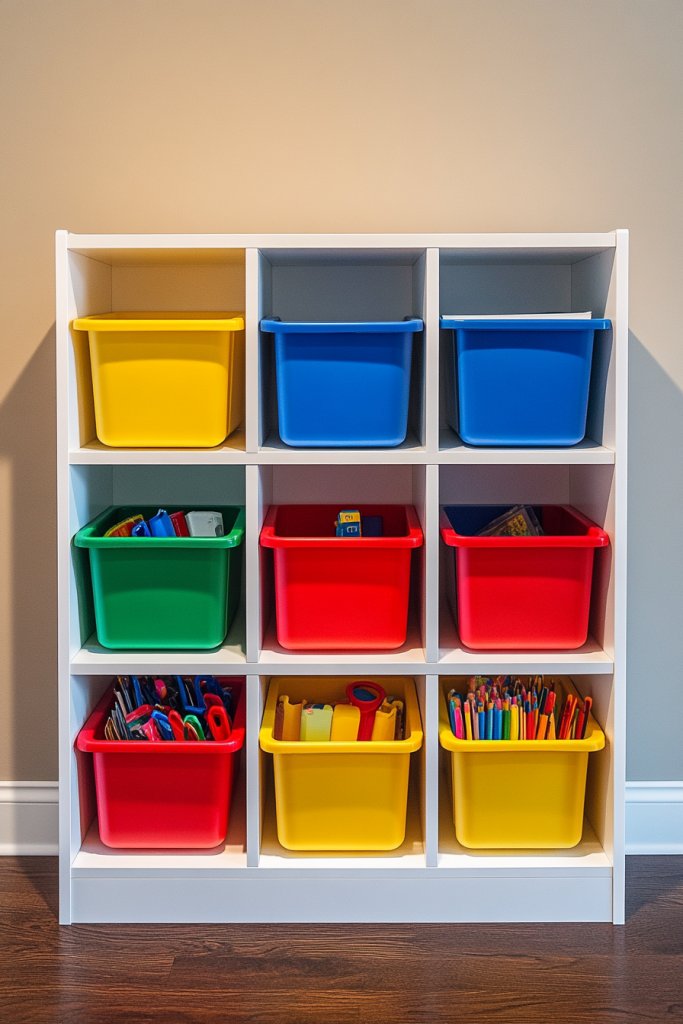
Cluttered shelves and scattered supplies can turn homeschooling into a chaos fest. Who wants to spend half the time hunting for crayons or math books? Modular cubby storage with color-coded bins offers a simple yet effective solution, turning disorder into order in seconds.
Recommended Products to replicate this idea
| # | Preview | Product | |
|---|---|---|---|
| 1 |

|
C&AHOME Cube Storage Organizer, 16-Cube Shelves Units, Plastic Storage Cubes, DIY Closet Organizer,... | Check Latest Price |
| # | Preview | Product | |
|---|---|---|---|
| 1 |

|
GAMENOTE Colored Plastic Storage Bins with Lids, Stackable Containers,Toy Storage Organizer - 5 Qt 6... | Check Latest Price |
It’s a game-changer for busy parents and organized kids alike. Picture a tall, sturdy cubby unit made of natural wood or sleek plastic, filled with vibrant bins in shades of blue, yellow, and red.
Each bin is labeled with clear, bold tags, making everything instantly identifiable. Art supplies, textbooks, and manipulatives are neatly tucked away, yet within arm’s reach.
The visual impact is cheerful and inviting, turning chaos into a colorful display of organization. Choose open-shelving for a modern, airy feel or enclosed units for a cleaner look.
Bins can be fabric, plastic, or woven—whatever matches your decor and budget. For small spaces, stackable or wall-mounted options maximize vertical storage.
Color schemes can be tailored to room themes or seasonal accents, keeping the setup fresh. Labels can be written with chalk, markers, or printed for a polished look.
Start by measuring your available space and selecting a cubby system that fits. Decide on the number of bins needed for different categories, and assign each a color for easy recognition.
Label each bin clearly with large, durable tags or printed labels. Set up the cubby in a central location, preferably near your main activity zone.
Fill the bins with sorted supplies, and switch out contents as needed to stay current. Regular tidying keeps the system functional and inviting.
Add decorative elements like patterned bin liners or fabric covers to soften the look. Customize labels with fun fonts or icons that appeal to your child’s interests.
Incorporate small chalkboard labels or dry-erase tags for quick updates. Use themed bins for holidays or special projects for added fun.
Personal touches make the storage feel less like a chore and more like a part of the room’s personality. A well-organized cubby system makes kids more independent and responsible for their materials.
It fosters pride in their space and teaches valuable life skills. Plus, a colorful, tidy room is just plain happier. Ready to swap clutter for clarity?
3. Adjustable Standing Desks for Flexible Learning Positions
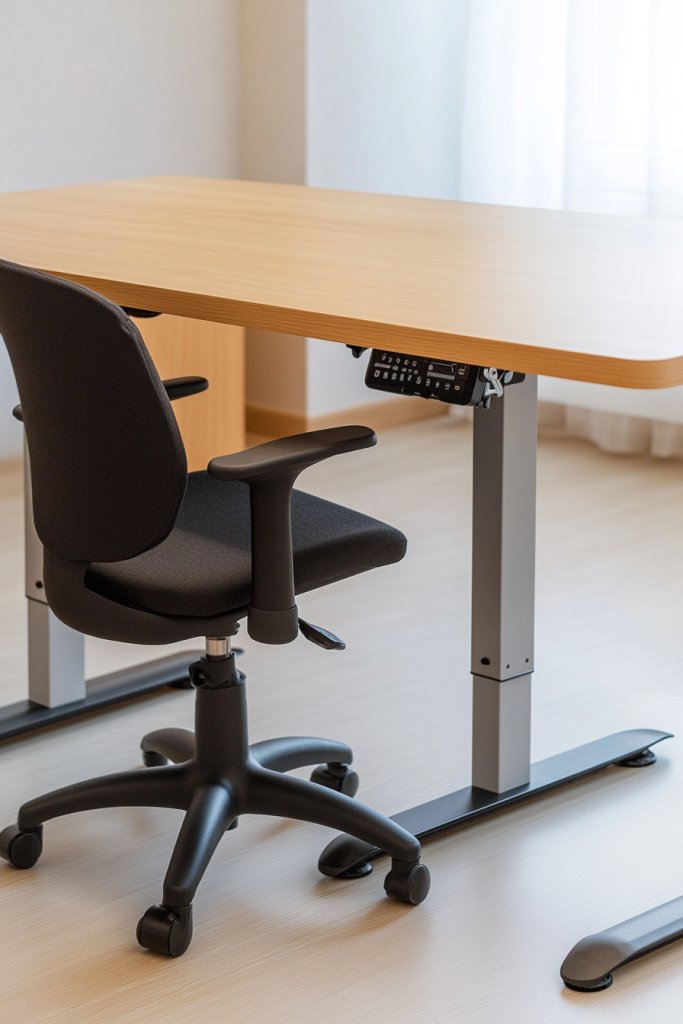
Sitting all day can make anyone feel sluggish, especially when you’re trying to focus on lessons at home. Adjustable standing desks offer a healthier, more dynamic way to learn—no more glued to the chair for hours.
Recommended Products to replicate this idea
| # | Preview | Product | |
|---|---|---|---|
| 1 |
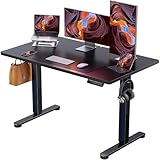
|
ErGear Height Adjustable Electric Standing Desk, 47.2 x 23.6 Inches Sit Stand up Desk, Memory... | Check Latest Price |
| # | Preview | Product | |
|---|---|---|---|
| 1 |

|
KitchenClouds Kitchen Mat Cushioned Anti Fatigue Rug 17.3"x28" Waterproof, Non Slip, Standing and... | Check Latest Price |
They help boost energy, improve posture, and make studying less of a chore. Who wouldn’t want a desk that moves with their mood? Visualize a sleek desk with a height-adjustable frame, topped with a sturdy surface in your favorite color or material.
Kids shift effortlessly between sitting and standing, thanks to a smooth mechanism. The room feels lively and adaptable, with a variety of activities happening simultaneously—reading, writing, or even hands-on projects.
The workspace encourages movement and keeps boredom at bay. Choose from minimalist metal frames or more decorative wood finishes that match your decor.
For shared spaces, adjustable desks can serve multiple users by simply changing height. Add a cushioned anti-fatigue mat for comfort during standing sessions.
Seasonal or themed desk covers can add personality, while ergonomic accessories enhance comfort. These desks work well in small nooks or larger homeschool setups.
Select a height-adjustable desk that fits your space and budget, ensuring it can handle your child’s height range. Assemble the frame according to instructions, then add a durable tabletop—wood, laminate, or even cork.
Teach your kids how to adjust the height safely and regularly check for stability. Position the desk near natural light and away from distractions.
Incorporate adjustable accessories like monitor stands or tray organizers to maximize efficiency. Regularly review ergonomics to prevent strain.
Customize with colorful desk mats, clipboards, or personalized nameplates. Use adjustable monitor stands or document holders to reduce neck strain.
Incorporate small storage containers on or under the desk for supplies to keep the surface clutter-free. Let your child choose a favorite color or theme for their workspace for added motivation.
The goal is a flexible, inviting environment that adapts as needs change. Encouraging movement while working boosts focus and reduces fatigue.
Kids learn to listen to their bodies and adopt ergonomic habits early. A versatile desk setup supports a variety of learning styles and activities, making education more enjoyable. Time to stand tall and embrace flexible learning?
4. Creative Wall-Mounted Magazine Racks for Art & Projects
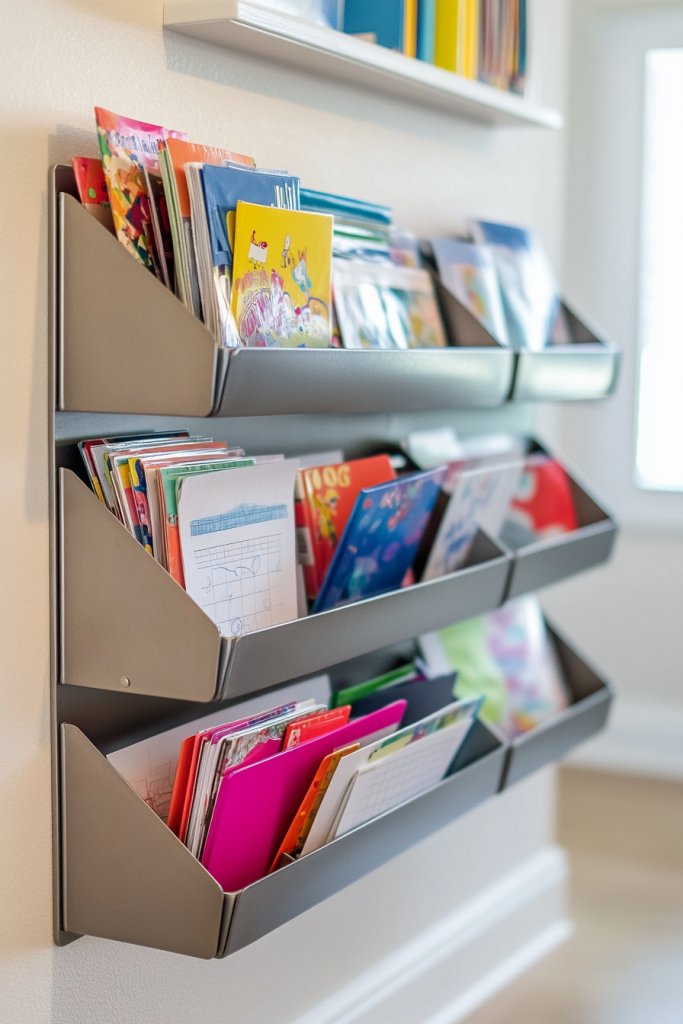
Cluttered tables and overflowing shelves can kill the vibe in a homeschool space. You need a smart way to display ongoing art projects, worksheets, or magazines without sacrificing precious surface area.
Wall-mounted magazine racks are a sleek, practical solution that keeps everything visible and accessible. Who says organization can’t be stylish? Envision a slim, metal or wooden rack mounted just above your work area.
It holds colorful magazines, art portfolios, and project sheets, all neatly fanned out for quick browsing. The rack’s open design adds an industrial or modern touch, while its vertical placement saves space.
Kids can easily grab or replace items, fostering independence and pride in their work. Pick a finish that complements your room—brushed metal for a contemporary look or painted wood for a cozy feel.
You can install multiple racks at different heights for various projects or age groups. For seasonal or themed displays, swap out magazines or artwork regularly.
Combine with clipboards or cork strips for extra display options, creating a dynamic, ever-changing gallery. Decide on the size and number of racks based on your available wall space.
Mount them securely using appropriate anchors for your wall type, ensuring they hold weight without sagging. Use labels or color-coded clips to categorize projects or subjects.
Encourage kids to curate their displays, fostering ownership. Regularly clear out completed projects to keep the display fresh.
Maintenance mainly involves dusting and updating contents. Personalize racks with painted accents or decorative stickers that match your decor theme.
Add small hooks underneath for hanging tools or accessories. Encourage children to decorate the rack itself with stickers or drawings, making it part of their creative expression.
Use themed bins or boxes underneath for supplies related to current projects. These small touches boost engagement and pride.
A dedicated display area celebrates your child’s creativity and progress, encouraging continuous effort. It turns your homeschool corner into a lively, inspiring space that motivates learning.
Kids see their work showcased and feel valued, building confidence one project at a time. Ready to turn blank walls into storytelling masterpieces?
5. Compact Rolling Cart for Mobile Learning Stations
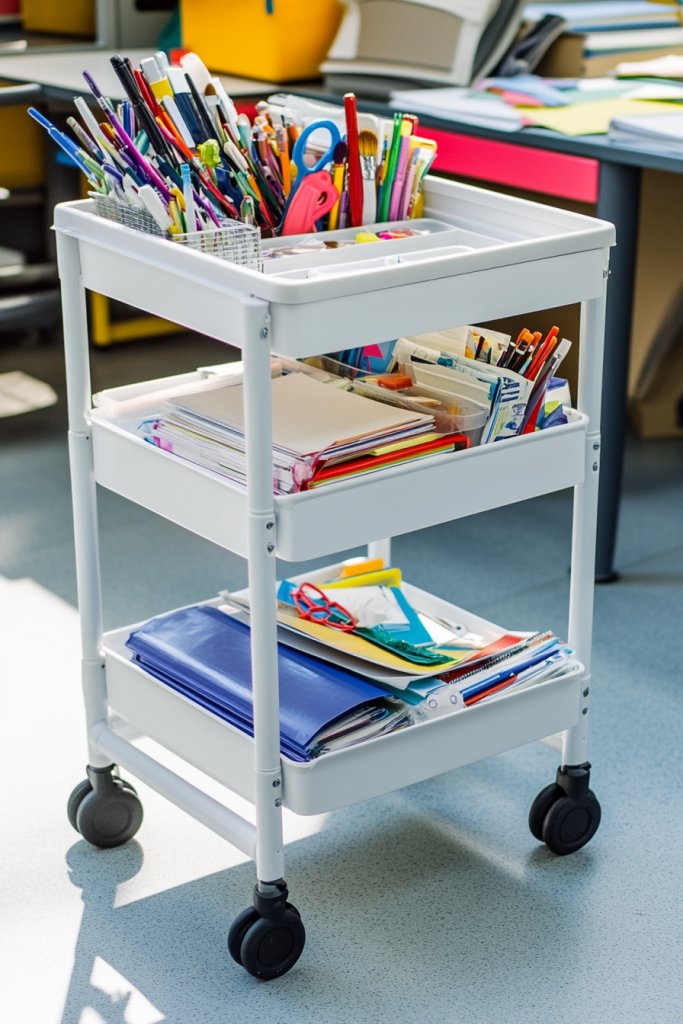
Ever wish your homeschool supplies could follow your child from desk to reading nook, without the clutter? A compact rolling cart makes learning portable, so everything needed for different activities stays close at hand. It’s perfect for dynamic spaces where flexibility is key.
Recommended Products to replicate this idea
| # | Preview | Product | |
|---|---|---|---|
| 1 |

|
Sywhitta 3-Tier Plastic Rolling Utility Cart with Handle, Multi-Functional Storage Trolley for... | Check Latest Price |
| # | Preview | Product | |
|---|---|---|---|
| 1 |

|
60 Pack 1.2" x 4.3" Self Adhesive Label Holders with 60Pcs Paper Label Inserts, Shelf Tag Label... | Check Latest Price |
Who says organization has to stay put? Picture a sturdy, multi-tiered cart with colorful labeled drawers and open shelves. It rolls smoothly on casters, allowing you to move it effortlessly across the room or store it away when not in use.
Filled with art supplies, manipulatives, or tech gadgets, it becomes a mini mobile classroom. The vibrant labels and neat arrangement make it inviting and easy to navigate.
Choose a sleek, minimal design for a modern aesthetic or a vintage-inspired cart for a cozy feel. The size can be tailored to hold everything from basic supplies to extensive kits.
For small rooms, opt for a slim profile that fits into tight corners. You can also customize drawer labels with fun icons or colors to match different subjects or themes.
Start by selecting a durable, lightweight cart with enough storage for your needs. Organize supplies into labeled bins or containers within the drawers or shelves.
Use clear labels for quick identification, and consider adding small hooks or clips for extra tools. When planning your layout, position the cart near your main workspace for convenience.
Regularly review and tidy the contents to keep it functional. Mobility allows you to adapt the space to different activities or guests easily.
Decorate the cart with stickers, washi tape, or your child’s favorite colors for a personalized touch. Attach small pouches or magnetic strips for frequently used tools.
Use themed labels or icons to make organization intuitive. Encourage your child to customize their station, fostering independence and pride.
These personal touches make the cart a fun part of the learning environment. A mobile learning station empowers children to take charge of their supplies and workspace.
It makes clean-up quick and easy, reducing frustration. Plus, it promotes independence and responsibility, key skills for life. Ready to roll into a more flexible, organized homeschool?
6. Personalized Learning Nook with Cozy Cushion Seating
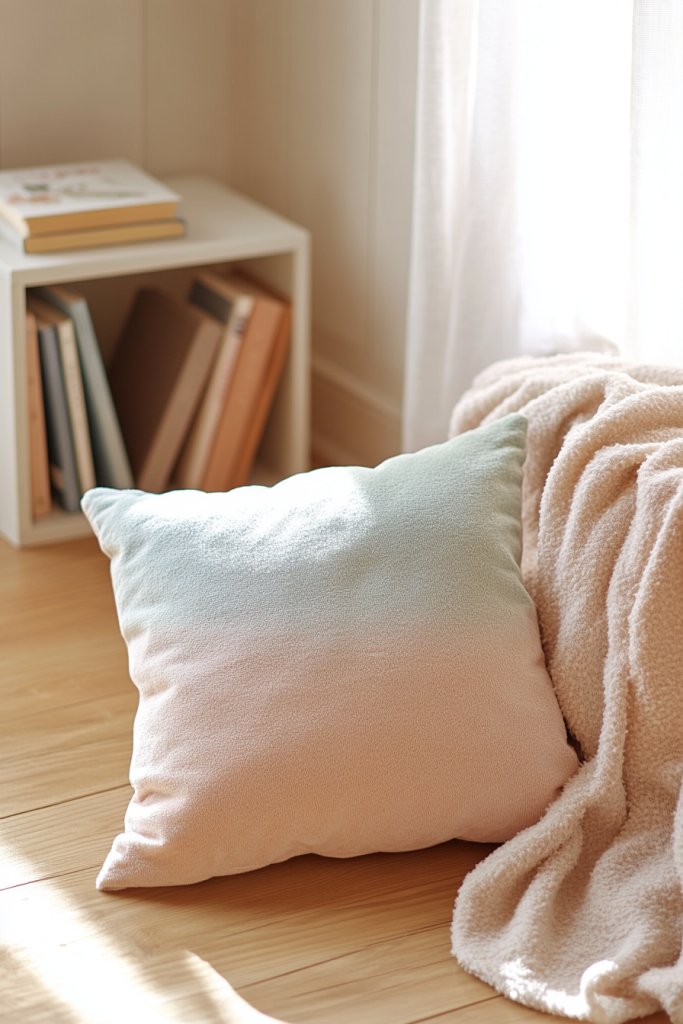
Sometimes, kids just need a quiet corner to dive into a book or work independently without distractions. A personalized learning nook offers a cozy retreat that makes studying inviting and less like a chore.
Recommended Products to replicate this idea
| # | Preview | Product | |
|---|---|---|---|
| 1 |

|
HIGOGOGO Round Stuffed Pouf Ottoman, Corduroy Poufs with Foam Chunk Filling, Furry and Fluffy Pouf... | Check Latest Price |
| # | Preview | Product | |
|---|---|---|---|
| 1 |

|
BAYKA Floating Shelves for Wall, Wall Mounted Rustic Wood Shelves for Bathroom, Bedroom, Living... | Check Latest Price |
It’s all about creating a space where your child feels comfortable and motivated to learn. Who wouldn’t want their own little sanctuary? Envision a small, inviting corner nestled in a quiet part of the room.
It features a plush cushion or a small armchair, surrounded by soft textiles and warm lighting. A small shelf holds favorite books, and a woven basket keeps supplies handy.
The space exudes comfort, with cozy textures like a chunky knit blanket and soft rugs inviting quiet moments. It’s a haven for focus and relaxation.
Use themed cushions, throws, or decorative pillows to match your child’s personality or room decor. For small spaces, a floor pouf or bean bag works well.
Larger rooms can accommodate a mini nook with a small desk and shelving. Seasonal decor, like fairy lights or themed cushions, can keep the space fresh and engaging.
This nook becomes a versatile spot for reading, art, or meditation. Identify a quiet corner or alcove in your home and add a comfortable seat suited to your child’s size.
Layer it with cushions or throws for extra comfort. Install a small shelf or basket nearby for books and supplies.
Personalize with favorite colors, patterns, or themes to make it special. Keep the area free of clutter to maintain a peaceful vibe.
Encourage your child to use this space regularly for quiet activities or one-on-one lessons. Let your child choose their favorite textiles, colors, or decorative items to make the space truly theirs.
Add a small chalkboard or whiteboard nearby for notes or motivational quotes. Incorporate sensory elements like soft rugs or textured cushions for added comfort.
Rotate decor seasonally to keep the nook fresh and exciting. Personal touches foster ownership and pride in their dedicated space.
A cozy nook encourages independent learning and self-directed activities. It helps children associate studying with comfort and safety, boosting confidence.
Creating a space tailored to their preferences makes them eager to spend time there. It’s a small step toward fostering lifelong habits of self-motivation and comfort in learning.
7. Clear Acrylic Document Holders for Paper Organization

Ever feel overwhelmed by stacks of worksheets, schedules, and reference sheets cluttering your workspace? Clear acrylic document holders offer a sleek, tidy way to keep important papers visible and accessible without chaos. They turn piles into organized displays that make flipping through papers effortless.
Recommended Products to replicate this idea
| # | Preview | Product | |
|---|---|---|---|
| 1 |

|
newnewshow 8.5x11 Acrylic Sign Holder 3 Pack Vertical Double-Sided Display (Optional 8.5x11 8.5x5.5... | Check Latest Price |
| # | Preview | Product | |
|---|---|---|---|
| 1 |
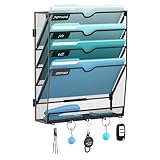
|
JMHUD 5 Tier Wall File Organizer - Hanging File Organizer with 5 Hooks, Mail Holder Wall Mounted for... | Check Latest Price |
Who knew clarity could make such a difference? Imagine a set of transparent vertical or horizontal acrylic trays mounted on the wall or sitting on your desk. The clear surfaces showcase your documents, with labels indicating categories like ‘To Do’, ‘In Progress’, or ‘Finished.’ The light passes through, giving a clean, modern look that blends with any decor.
Papers are easy to find and quick to replace, reducing stress and saving time. Choose from wall-mounted options for saving space or desktop trays for easy access.
Stackable or tiered designs maximize storage without taking up extra room. Customize labels with colorful markers or printed tags for quick identification.
For seasonal or themed projects, swap out papers easily, keeping your organization fresh and relevant. Start by selecting acrylic holders that fit your space and paper sizes.
Mount wall organizers at eye level for quick access, using appropriate anchors. Label each section clearly and set up a routine for filing or clearing papers weekly.
Use different colors or labels for various subjects or priorities. Keep supplies like pens and extra labels nearby for easy updates.
Regularly review and purge outdated or finished documents. Add decorative touches like colored borders or fun stickers to labels.
Incorporate a small chalkboard or dry-erase label for quick notes or updates. Use themed or seasonal labels to match your decor or calendar.
Let your kids decorate their labels or sections to foster ownership. These small tweaks make organization feel less like a chore and more like a fun activity.
Clear document holders promote responsibility and independence in managing their materials. They teach organizational skills that will benefit them for life.
Seeing a tidy, well-organized workspace boosts confidence and reduces frustration. It encourages a habit of neatness and mindfulness—key ingredients for successful learning.
8. Space-Saving Wall Shelves for Books and Educational Decor
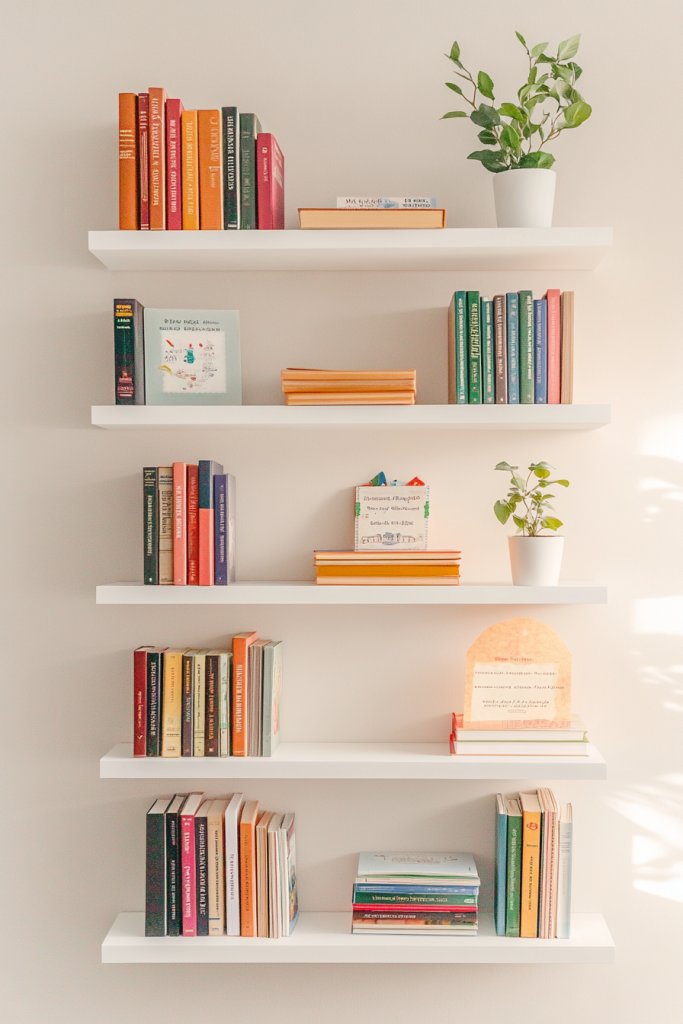
Cluttered tables and crowded corners make it tough to focus on learning. You need a way to display books and inspirational materials without sacrificing space.
Space-saving wall shelves are the perfect solution—they keep essentials within reach and free up your work surfaces. Who doesn’t love more room to breathe? Visualize slim, floating shelves mounted along a wall, holding a collection of colorful books, posters, or decorative items.
The shelves are minimalist but sturdy, creating a clean, organized look. They run horizontally or vertically, maximizing vertical space.
The arrangement invites curiosity and makes everything easy to grab or swap out as needed. Pick sleek, modern materials like metal or wood, or go for playful, colorful designs for a kid-friendly vibe.
Install multiple shelves at different heights to accommodate various items or create a gallery wall effect. Combine with pinboards or clips for quick display changes.
Seasonal or themed decor can be added by swapping items or changing shelf arrangements, keeping the space lively. Measure wall space carefully and select shelf sizes accordingly.
Mount shelves securely into studs or wall anchors to ensure safety and stability. Organize books by size, subject, or color for visual impact and ease of use.
Use small decorative objects or educational posters to complement the shelves without overcrowding. Regularly tidy and rotate items to keep the display fresh and inspiring.
Add decorative edging or painted accents to shelves to match your decor. Incorporate small labels or tags for books or materials, encouraging kids to organize their collections.
Hang themed banners or alphabet decals nearby for extra educational flair. Let children help arrange the shelves or choose what to display, fostering a sense of ownership.
Personalized touches make the space truly theirs. A well-organized display of books and materials sparks curiosity and a love for learning.
Kids learn to value neatness and organization from a young age. Seeing their favorite books on display encourages independent browsing and reading. It transforms the room into an inspiring, accessible library that motivates active engagement.
9. Labelled Storage Bins with Clear Lids for Easy Access
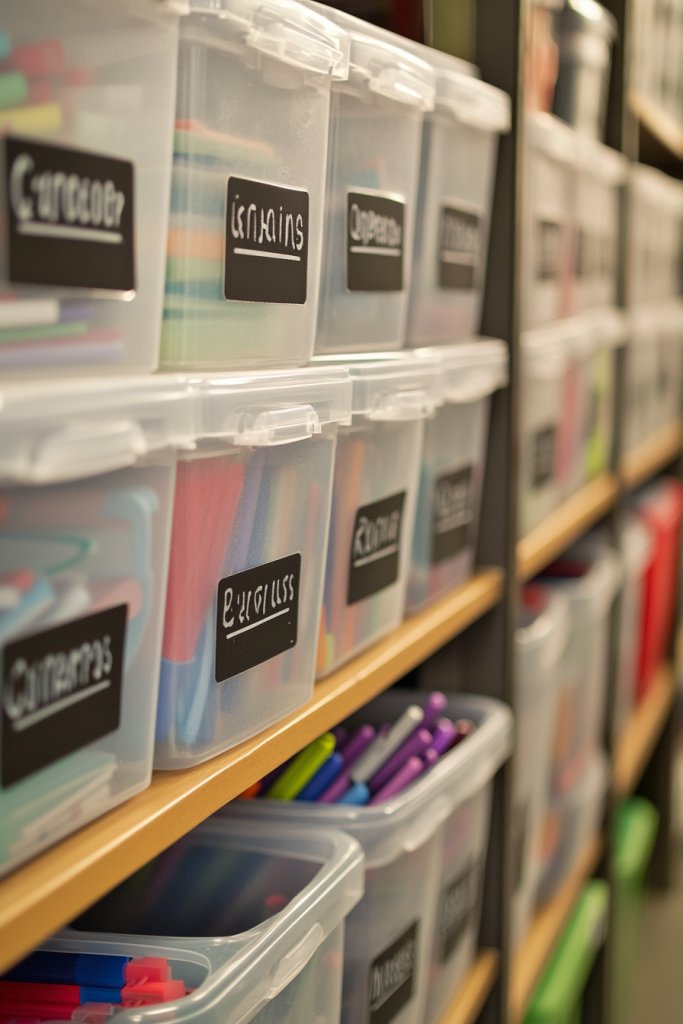
Messy bins and unlabeled containers make cleanup a nightmare. You want a straightforward way for your kids to find and put away supplies without constant supervision.
Recommended Products to replicate this idea
| # | Preview | Product | |
|---|---|---|---|
| 1 |

|
IRIS USA 13 QT Plastic Storage Box with Lid and Latches - 6 Pack - BPA-Free, See-Through Organizing... | Check Latest Price |
| # | Preview | Product | |
|---|---|---|---|
| 1 |

|
Avery Multi-Use Removable Labels, 1" x 3", White, Non-Printable, 72 Blank Labels Total (6728) | Check Latest Price |
Labeled storage bins with clear lids offer clarity and order, turning chaos into calm. Who knew that a simple label could save so much time? Visualize a set of uniform bins stacked neatly on shelves or in a closet, each with a bold label indicating contents like ‘Markers’, ‘Puzzle Pieces’, or ‘Small Toys’.
The transparent lids let you peek inside without opening, speeding up the search process. The labels are large and colorful, making it easy for kids to identify and remember where things go.
The overall look is tidy, organized, and inviting. Choose from plastic, fabric, or wooden bins depending on your decor and budget.
Use color coding to differentiate categories or age groups. For seasonal items, swap out contents and update labels for relevance.
Stackable designs maximize vertical space, especially in small rooms. Labels can be handwritten, printed, or laminated for durability.
Sort supplies into categories and assign each to a bin. Label each container clearly with large, easy-to-read tags or stickers.
Arrange bins on open shelves, inside cabinets, or in storage cubes. Make sure lids are secure yet easy for small hands to open.
Regularly review and declutter to maintain organization. Teach kids to put things back after use, reinforcing good habits.
Decorate labels with fun fonts, icons, or stickers that appeal to your child’s interests. Use themed labels for holidays or special projects to keep things fresh.
Incorporate personalized tags with your child’s name or favorite colors. Consider adding small decorative touches like washi tape around lids for extra flair.
These details turn practical storage into a fun part of the room. Labeling and organizing supplies builds responsibility and independence in children.
It reduces frustration during cleanup and encourages them to take ownership of their space. A tidy, labeled environment fosters pride and a sense of achievement. Ready to make organization simple and accessible?
10. Under-Desk Storage Solutions for Extra Supplies
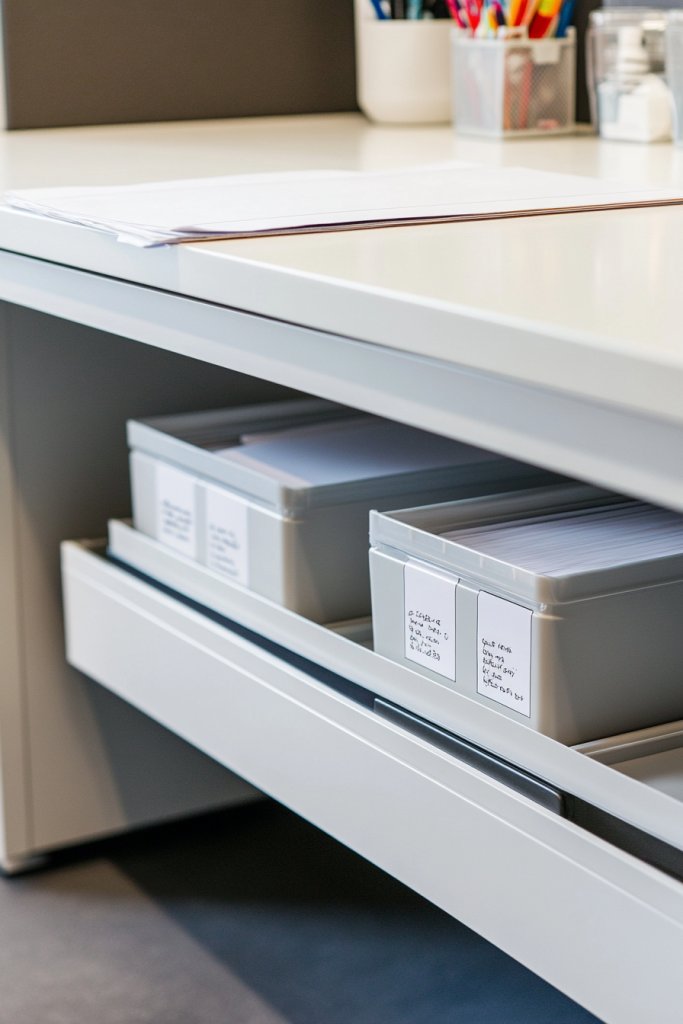
Cluttered desktops can kill concentration faster than a bad coffee. You need a clever way to stow away extra supplies without sacrificing workspace.
Under-desk storage solutions hide the mess and free up valuable surface area for active learning. Who says organization has to be obvious? Picture a set of small baskets, drawers, or trays tucked neatly beneath your child’s desk.
They hold supplies like extra pencils, paper, or craft materials, out of sight but within easy reach. The space beneath the desk is optimized with compartments that slide out or lift for quick access.
It keeps the desktop clean, bright, and inviting, turning clutter into hidden treasure. Use fabric baskets or plastic drawers that fit your desk size and style.
For a tidy look, label each compartment clearly with large tags or stickers. For small spaces, stackable or modular options maximize vertical space.
For creative flair, add colorful liners or decorative labels that match your room’s theme. Seasonal or project-based storage can be rotated to keep the setup fresh.
Measure the space beneath your child’s desk and select storage containers accordingly. Organize supplies into categories—art, stationery, tech—and label each for quick identification.
Place the containers in a way that allows easy sliding or lifting without disturbing the workspace. Encourage your child to put things back after each session, fostering responsibility.
Regularly review contents to remove used or outdated items. Maintenance involves simple tidying and re-labeling when necessary.
Decorate storage containers with stickers or washi tape to personalize them. Use color coding to match storage with different subject areas or activities.
Incorporate small decorative elements like charms or themed labels for extra fun. Let your child choose the colors or patterns to foster ownership.
These small personal touches make organization feel more engaging and less like a chore. Under-desk storage teaches kids responsibility for their belongings and helps them develop organizational skills early.
It makes cleaning up quick and easy, reducing frustration and encouraging independence. A tidy workspace boosts focus and confidence, making learning more productive. Ready to keep the clutter out of sight and mind?
11. DIY Pegboard Organizer for Supplies & Tools
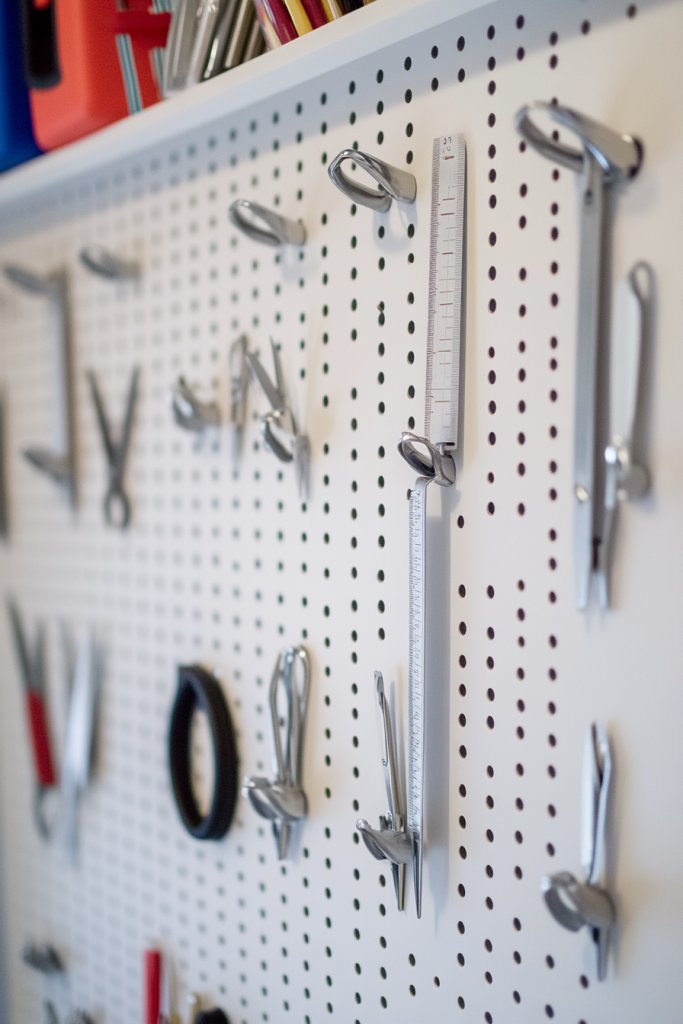
Messy drawers and scattered supplies slow down your homeschool flow. You want a way to keep essential tools like scissors, rulers, and flashcards within arm’s reach, without cluttering your workspace.
A DIY pegboard is the perfect customizable solution that keeps everything organized and visible. Who knew a simple wall panel could be so versatile? Imagine a sturdy pegboard mounted at a comfortable height, filled with hooks, baskets, and pegs holding supplies in easy view.
Rulers hang neatly, scissors are within easy reach, and small baskets hold flashcards or small tools. The open design feels industrial yet inviting, with a mix of colors and textures that match your decor.
It becomes a central hub for quick access and organization. Paint the pegboard in a bold color or leave it raw for an industrial look.
Customize with different hooks, baskets, or labels to suit your needs. For smaller items, add small bins or magnetic holders.
For aesthetic appeal, arrange items symmetrically or in themed zones. Modular setups allow expansion as your collection of supplies grows or changes.
Choose a sturdy pegboard that fits your space and style, then mount it securely using appropriate anchors. Sort supplies into categories and assign hooks or baskets accordingly.
Label each section with durable tags or stickers for clarity. Organize frequently used tools at eye level for quick access.
Regularly review and tidy the setup, replacing or relocating items as needed. This DIY project can be completed in an afternoon with basic tools.
Decorate the pegboard with themed stickers or paint accents matching your room decor. Personalize with custom labels or icons that make it fun for kids.
Add decorative elements like small flags or themed magnets for extra flair. Encourage your children to arrange and maintain their tools, fostering responsibility.
Small aesthetic upgrades make the system both functional and attractive. A well-organized pegboard boosts efficiency and independence, helping kids manage their supplies confidently.
It makes cleanup easier and teaches valuable life skills. Seeing their tools neatly arranged and readily available encourages a sense of mastery. Ready to turn a blank wall into a DIY organizational hub?
12. Stylish Fabric Bins for Hidden Storage
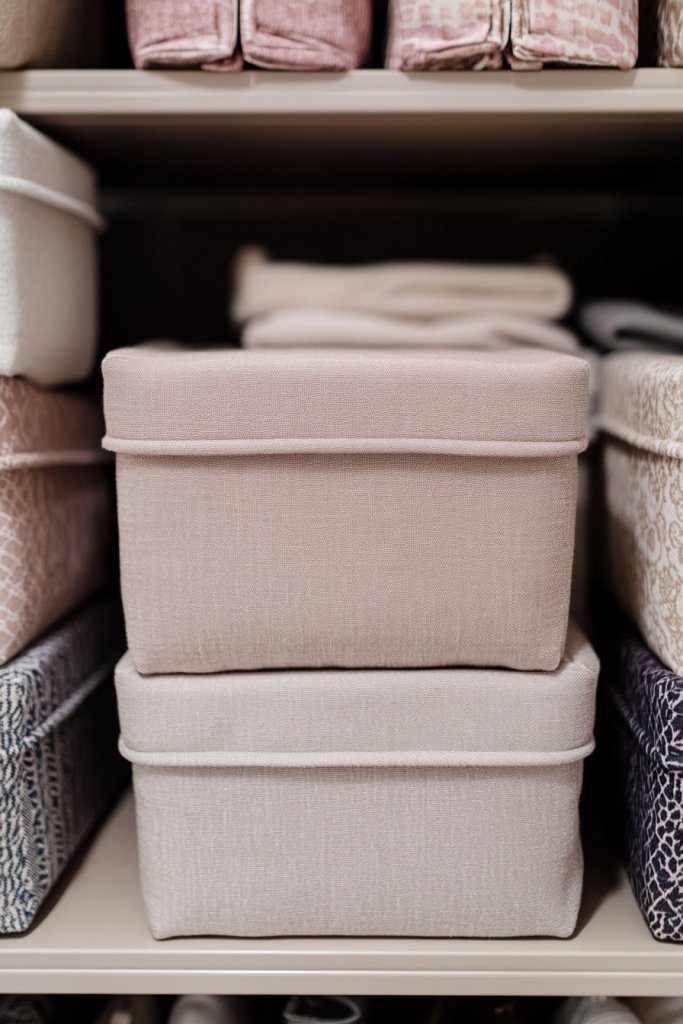
Baskets and boxes are great for storage, but plain plastic or cardboard bins can look dull and cluttered. You want a way to hide supplies while adding a touch of style to your homeschool room.
Stylish fabric bins combine practicality with aesthetics, making organization feel less like a chore and more like decor. Who says storage can’t be chic? Picture soft fabric bins in neutral tones or bold patterns, sitting on open shelves or tucked into corners.
They hold larger items like seasonal supplies or craft kits, hidden yet easily accessible. The textured fabric adds warmth and softness, contrasting with sleek surfaces or painted walls.
The bins blend seamlessly into your decor, turning clutter into a curated look. Choose from woven, quilted, or linen fabrics depending on your aesthetic.
Use bins with handles for easy transport or collapsible designs for space-saving flexibility. Coordinate with your room’s color palette or add decorative trims for a personalized touch.
Seasonal or themed fabrics can be swapped out to keep the look fresh. These bins work equally well in open shelving or under desks.
Select fabric bins that fit your storage needs and space. Fill them with categorized supplies like art materials, stationery, or toys.
Label the bins with fabric-safe tags or iron-on labels for durability. Place them strategically on shelves or in closets for neatness.
Regularly review contents and fold or replace worn fabrics. Simple, stylish, and effective—these bins make storage feel effortless.
Add decorative touches like ribbons, embroidered initials, or themed patches. Mix and match fabrics to create a playful or sophisticated look.
Use matching labels or tags to unify the design. Encourage your kids to choose their favorite patterns, fostering a sense of ownership.
These details turn functional storage into a decorative statement. Stylish storage solutions make tidying up less of a hassle and more of a pleasure.
They teach children to value neatness and take pride in their organized space. A cozy, attractive environment promotes focus and positive attitudes toward learning. Ready to add a touch of elegance to your homeschool storage?
13. Creative Desk Zones for Different Subjects
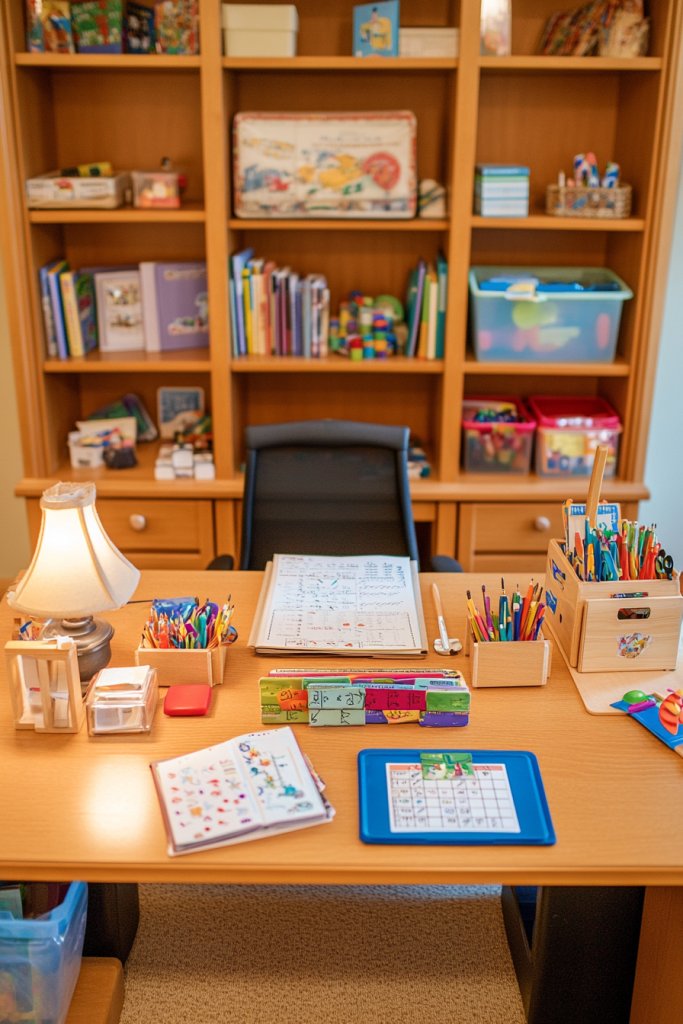
Mixing all subjects in one cluttered space can make focus and organization a mess. Kids benefit from designated zones that clearly separate reading, math, art, and other activities.
Recommended Products to replicate this idea
| # | Preview | Product | |
|---|---|---|---|
| 1 |

|
Ophanie Area Rugs for Living Room Bedroom, Upgrade Non-Slip Fluffy Soft Grey Shag Carpet, Indoor... | Check Latest Price |
| # | Preview | Product | |
|---|---|---|---|
| 1 |

|
Furinno LUDER Book Shelf, 5-Cube Bookshelf, Reversible Bookcase, 9.4 x 19.5 x 31.5, for Living Room,... | Check Latest Price |
Creating specific areas within your homeschool room helps children switch gears easily and stay engaged. Who wouldn’t want a room that naturally guides their learning flow? Visualize a room divided into small zones, each with its own color rug, border decal, or themed decor.
A cozy reading corner with a plush cushion, a math station with manipulatives, and an art nook with supplies—all distinctly marked. Each zone has its own mini setup, making it easy for kids to know where to go for each activity.
The visual cues encourage independence and focus. Use different colored rugs or wallpaper decals to define each zone, matching your child’s personality or learning style.
Install low bookshelves, small tables, or activity mats within each area. For rooms with limited space, fold-away or multi-use furniture helps maximize space.
Seasonal or project-based zones can be created with temporary decor, keeping the environment dynamic. This approach fosters a structured yet flexible learning environment.
Map out your room to identify logical zones based on space and activities. Use color, borders, or furniture placement to visually separate each area.
Equip each zone with necessary supplies, and label storage or stations clearly. Encourage your child to respect each zone’s purpose, fostering responsibility.
Rotate or adapt zones seasonally or as interests change to keep engagement high. Regularly assess the setup for functionality and flow.
Let your child decorate or personalize each zone with their favorite colors or themes. Use printable labels, decals, or small signs to reinforce each area’s purpose.
Incorporate special touches like themed cushions or small decor items that match the zone’s activity. Invite your child to help rearrange zones or add new elements, fostering ownership.
These personal touches make learning zones inviting and fun. Dedicated zones promote independence, responsibility, and focus.
Kids learn to transition smoothly between activities and take pride in their organized space. Visual cues reinforce routines and help develop organizational skills early. Transform your room into a structured, inspiring environment that makes learning feel natural.
14. Multi-Purpose Fold-Down Table for Space Efficiency
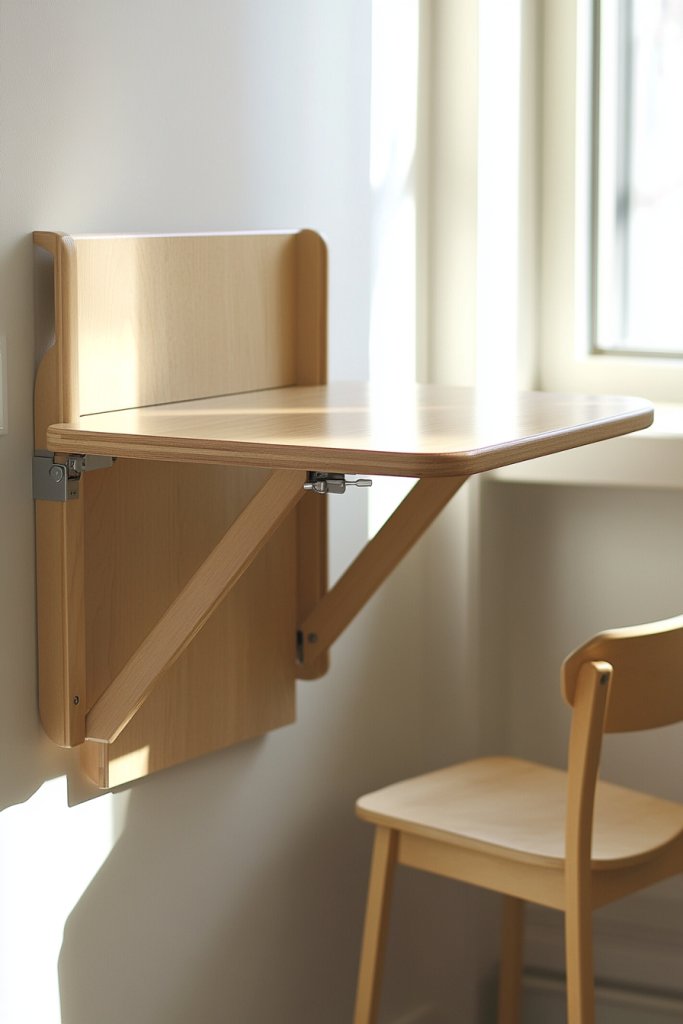
Limited space can make a full homeschool setup feel cramped and cluttered. You want a versatile table that can expand for lessons and fold away when not needed.
A multi-purpose fold-down table offers space efficiency without sacrificing functionality. Who says you can’t have a roomy workspace in a small room? Picture a sleek wall-mounted table that folds down when in use, revealing a sturdy surface in a neutral or vibrant color.
When folded up, it tucks neatly against the wall, freeing up floor space. It’s perfect for quick lessons, art projects, or even as a craft station.
Brightly colored or patterned edges add personality and make it inviting. Choose a fold-down table with a smooth, wipeable surface for easy cleaning.
Match it with your room’s decor—wood finishes for rustic charm or sleek laminates for modern appeal. Install adjustable or removable legs if needed, or opt for a wall panel that acts as both a desk and a chalkboard surface.
It can serve multiple functions, from homework station to craft area. Securely mount the table on a wall using heavy-duty brackets, ensuring it can support your child’s weight.
Decide on the best height for your child’s comfort, and install the mechanism carefully to allow smooth folding and unfolding. Keep cleaning supplies or art tools nearby for quick access.
When not in use, fold the table up to keep the room open and versatile. Regularly check the mounting hardware for stability.
Decorate the table with colorful edges, decals, or personalized labels for a fun touch. Add small storage pockets or clipboards for supplies when the table is folded down.
Encourage your child to help with the setup and decoration to foster ownership. Seasonal or themed covers can be added for special occasions, keeping the space lively and inviting.
A fold-down table maximizes space and encourages adaptable learning. It helps children develop organizational skills by managing a multi-use area.
When they see how a small space can serve many needs, their confidence in managing their environment grows. Ready to fold out a new level of space-saving brilliance?
15. Inspirational Quote Wall Decals for Motivation
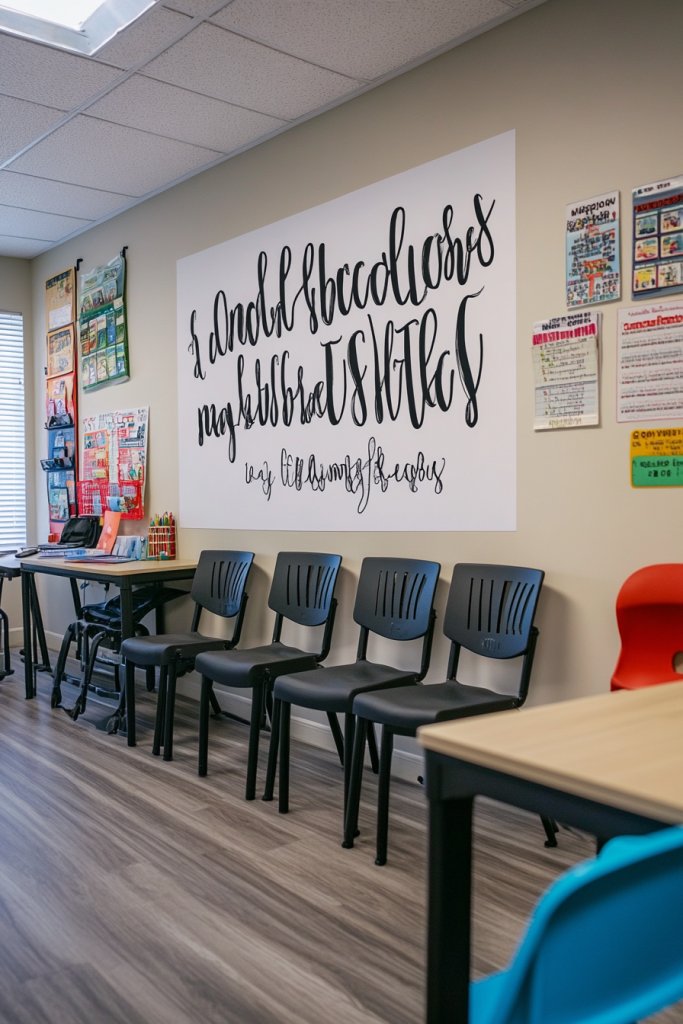
Sometimes, all it takes is a little encouragement to ignite a love for learning. Wall decals with inspirational quotes can create a positive, motivating atmosphere right where your kids learn.
They serve as visual reminders that education is a journey worth celebrating. Who doesn’t need a daily dose of inspiration? Visualize a large, removable decal on a blank wall featuring uplifting words like ‘Dream Big’, ‘You Can Do It’, or ‘Every Day Counts’.
The quotes are in bold, playful fonts that catch the eye, complemented by decorative elements like stars or banners. The decals are easy to apply and remove, allowing for seasonal or mood-based updates.
The room instantly feels more lively and encouraging. Select decals with different fonts, colors, or themes to match your decor style.
Create a gallery wall with a mix of quotes, affirmations, and motivational sayings. For a personalized touch, add your child’s favorite phrases or words of encouragement.
Incorporate decals into other decor elements like bulletin boards or shelves for a cohesive look. Choose an appropriate spot with good visibility—above the workspace or on a blank wall.
Clean the surface thoroughly before applying decals to prevent bubbles. Arrange the quotes visually before sticking to ensure proper placement.
You can layer decals or group them for impact. When changing quotes, remove carefully to avoid damaging the wall or decal.
Regular updates keep the space fresh and inspiring. Involve your child in choosing or designing their favorite quotes, fostering ownership.
Add small decorative elements like washi tape or stickers around the decals. Consider creating a mini ‘inspiration board’ where new quotes can be added regularly.
Use different textures or materials like fabric patches or metallic foils for a unique look. Personalization makes the motivational space truly theirs.
Inspirational quotes boost morale and foster a growth mindset. They remind children of their potential and encourage perseverance through challenges.
A positive environment helps build resilience and a love for learning. Ready to inspire your young learners every day?
16. Tiered Storage Trays for Daily Supplies
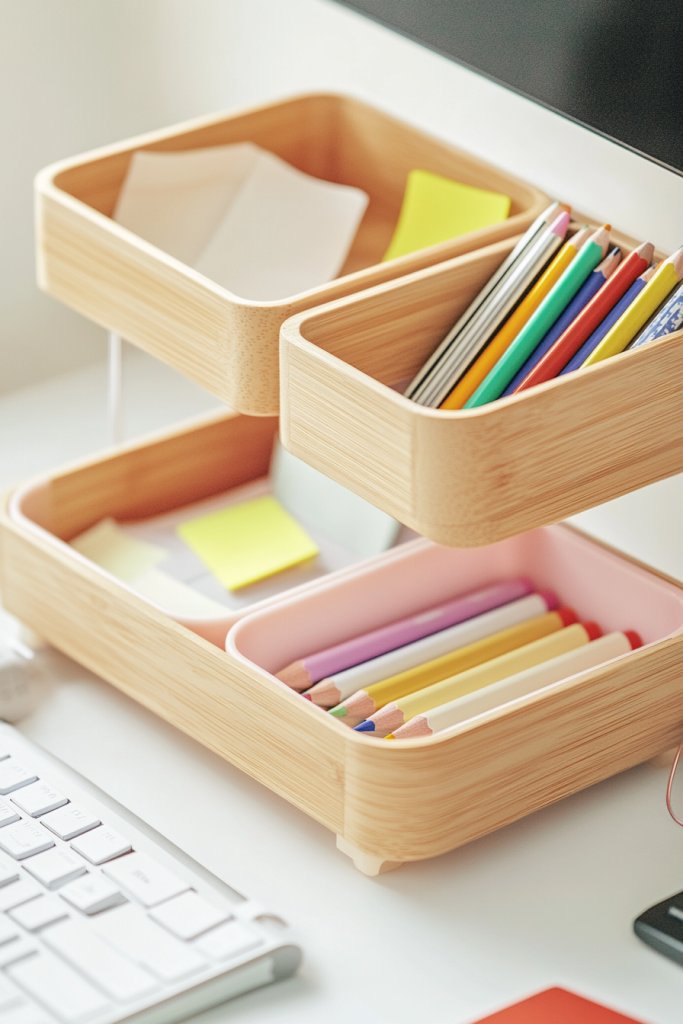
Constantly digging through piles of pencils, sticky notes, and erasers wastes time and kills focus. You need an organized way to keep daily essentials within easy reach.
Tiered storage trays or desktop caddies are perfect for sorting supplies by priority or type. Who wants to spend more time searching when everything is at their fingertips? Visualize a sleek, multi-level tray sitting on your child’s desk, filled with neatly sorted supplies—pencils on one level, erasers on another, and sticky notes in a small compartment.
The tiers are clear and accessible, with labels or color coding to differentiate categories. The setup is compact yet highly functional, making daily routines smoother and more organized.
The visual appeal is clean and inviting, inspiring tidiness. Choose from plastic, bamboo, or metal trays depending on your decor style.
Stackable or expandable options grow with your needs. For small spaces, slim vertical trays fit perfectly in corners or on shelves.
Customize with labels or colored dividers to keep everything sorted. Seasonal or project-based setups can be easily adapted for different activities or themes.
Select a tray that fits your workspace and supplies. Organize items into categories and assign each a specific tier or compartment.
Label each section clearly with durable tags or stickers. Keep frequently used items at the top or in the front for quick access.
Regularly review and tidy the trays to prevent overflow or clutter. Encourage your kids to put supplies back after each use, fostering responsibility.
Decorate labels with fun fonts or icons that your child loves. Use color-coded dividers or stickers to reinforce organization.
Let your child decorate or personalize the tray with drawings or stickers. Incorporate themed or seasonal labels for variety and fun.
These small touches make organization a rewarding part of their routine. Having organized daily supplies promotes independence and responsibility.
It reduces frustration and makes learning more efficient. When everything has a designated place, kids feel in control and confident.
An organized workspace fosters a positive attitude toward learning and self-management. Ready to streamline your child’s daily routine?
17. Minimalist Desk Setup for Focused Learning
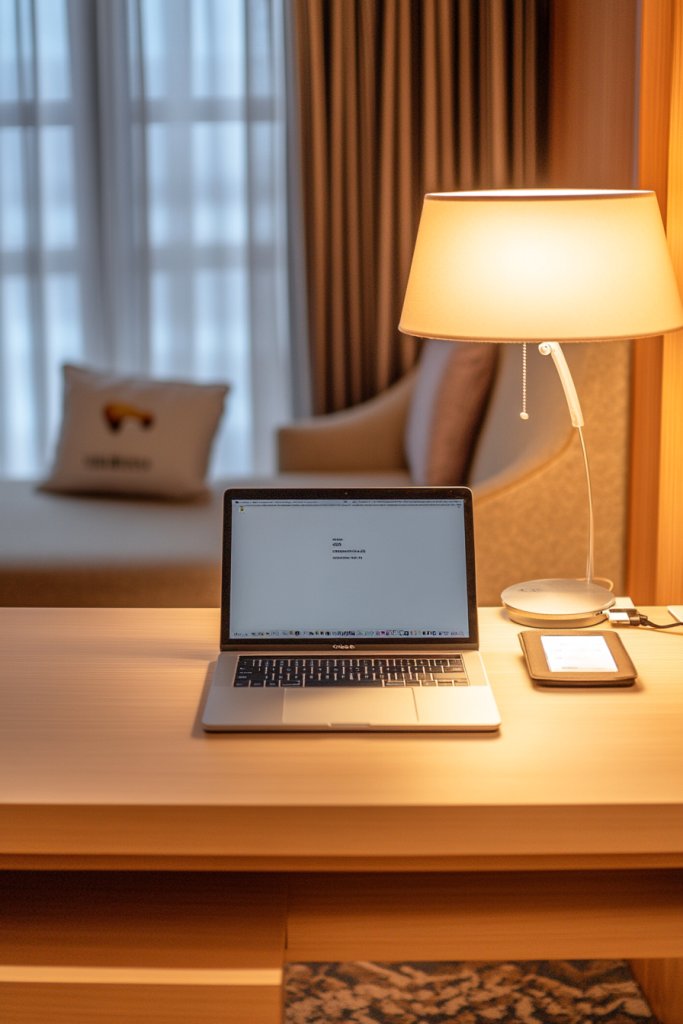
Cluttered desks and excessive decor can distract even the most motivated learners. You want a clean, simple workspace that encourages focus and calmness.
A minimalist desk setup strips away the unnecessary, leaving only what’s essential. Who knew that less could be so much more? Imagine a sleek, uncluttered desk with a smooth surface, a single lamp, and a minimal set of supplies neatly arranged.
The space is free of distractions, with only a notebook, a pen, and a small organizer for essentials. Neutral tones or monochrome accents create a peaceful atmosphere.
The room feels open, inviting concentration rather than chaos. Opt for neutral colors like white, gray, or beige for a calming vibe.
Keep decorations to a minimum—perhaps a single framed quote or a small plant (if you can handle the green stuff). Use hidden storage or drawers to keep supplies out of sight.
For portable setups, a foldable or lightweight desk is perfect for easy storage and transport. The goal is a clutter-free zone that promotes productivity.
Clear your existing desk and remove all non-essential items. Choose a desk with clean lines and simple design, and organize only necessary supplies on top.
Use small, discreet containers inside drawers for tidying. Keep surfaces bare and add only a few motivational elements, like a quote or a single decorative piece.
Regularly review and declutter to maintain the minimalist aesthetic. This setup helps hone focus and encourages discipline.
Personalize with subtle touches like monochrome artwork or a single favorite quote in sleek lettering. Use storage solutions that blend seamlessly with the desk, such as built-in compartments.
Incorporate a simple color scheme to unify the look. Let your child help choose their favorite minimal decor to foster ownership.
The result is a space that feels peaceful and purpose-driven. A minimalist workspace minimizes distractions and maximizes focus.
It teaches children to value simplicity and organization, skills that benefit all areas of life. A clean space reduces anxiety and promotes clarity of thought.
When their environment is calm, their confidence in tackling tasks grows. Ready to embrace the art of less?
18. Rolling Whiteboards for Group or Individual Practice
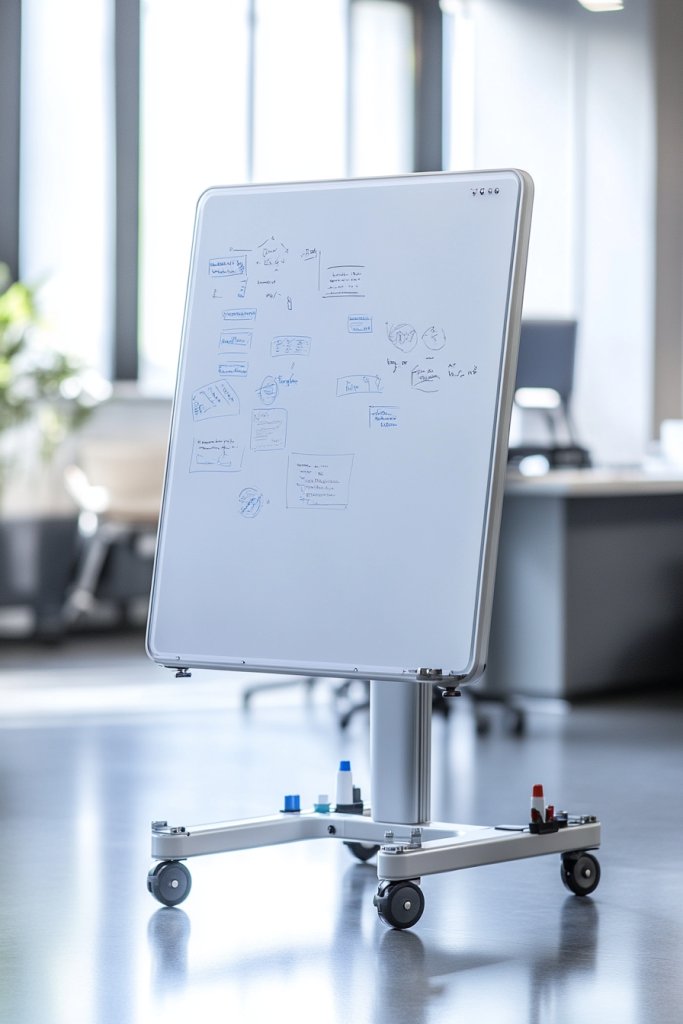
Static whiteboards limit flexibility in teaching and practice. You want a mobile solution that allows for group activities, individual work, or brainstorming sessions anywhere in the room.
Rolling whiteboards are perfect—they move where the action is and make lessons more interactive. Who says learning has to stay in one spot? Picture a sturdy whiteboard on wheels, easily moved to different parts of your homeschool space.
It’s filled with colorful markers, magnets, and sticky notes, ready for lessons or creative exercises. Kids gather around for group discussions or work solo, using the whiteboard as their canvas.
Its mobility creates a dynamic learning environment that adapts to your needs. Select a whiteboard with a sleek frame or a fun, themed design to match your decor.
Use magnets or clips for visual aids, charts, or notes. For smaller spaces, choose a compact size; for larger rooms, a bigger board offers more space.
Combine with storage bins or shelves for markers and erasers. The mobility allows you to reconfigure your space quickly for different activities.
Mount the whiteboard on sturdy casters, ensuring they lock securely when in use. Place it near your main teaching area or in a central location.
Stock it with markers, erasers, and accessories, and teach your kids how to use and care for it. Use the whiteboard for lessons, games, or collaborative projects.
Regularly clean and update content to keep it relevant and engaging. Flexibility is key—adapt as your needs evolve.
Decorate the frame with colorful tape or stickers to make it fun and inviting. Personalize with your child’s name or favorite themes.
Use themed magnets or sticky notes to match seasons or subjects. Encourage kids to decorate or add their own notes, fostering ownership.
These small touches turn a simple whiteboard into a creative tool. A portable whiteboard promotes active participation and collaboration.
Kids learn to express ideas visually and work together confidently. It’s a tangible way to boost engagement and make lessons memorable. Ready to move your learning to the next level?
19. Customizable Wall Hooks for Bags & Aprons
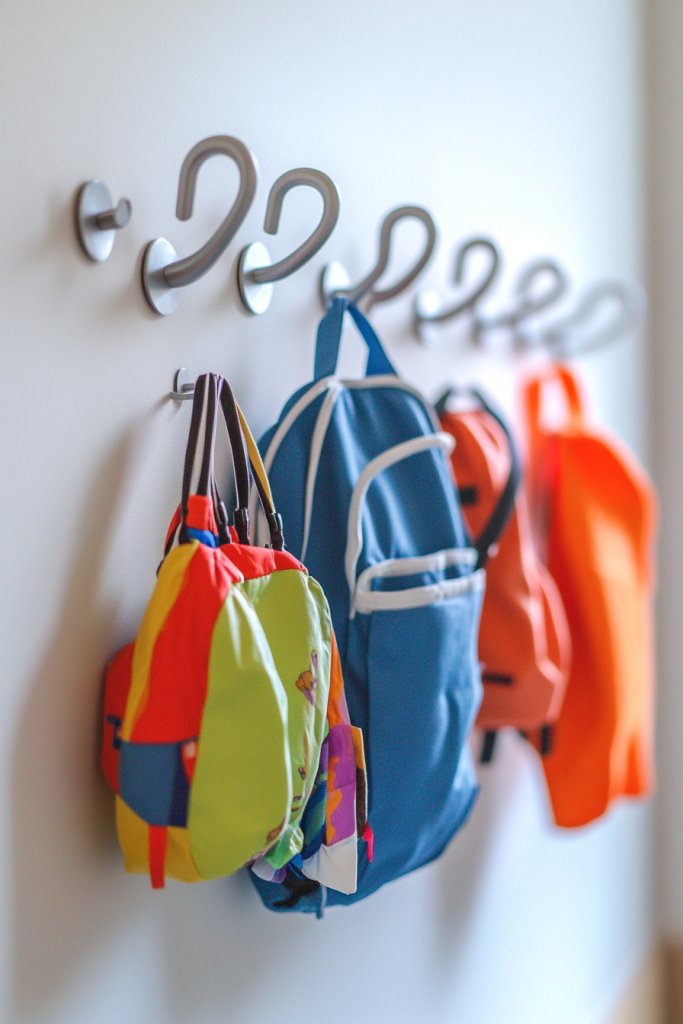
Cluttered floors and tangled bags can turn your homeschool into a disorganized mess. You need a designated spot for backpacks, aprons, or outdoor gear that’s easy to access and keeps clutter off the ground.
Customizable wall hooks are a simple, effective way to keep everything in its place. Who doesn’t want a tidier, more functional space? Imagine decorative hooks mounted neatly at a child-friendly height, holding backpacks, aprons, or hats.
The hooks are colorful, themed, or personalized with names or symbols, making them fun for kids. The wall looks tidy and inviting, with everything in easy reach.
It’s a practical yet playful addition that keeps clutter contained. Choose hooks in different colors, shapes, or materials—wood, metal, or plastic—to match your decor.
Install multiple hooks for different items or multiple children. Use decorative wall decals or paint to enhance the look.
Hooks can be arranged in a row or clustered for a playful effect. Seasonal or themed hooks can be swapped out for variety.
Select wall hooks that can support the weight of backpacks and outdoor gear. Mount them at a height suitable for your children, ensuring stability.
Label hooks with names or icons for easy identification. Encourage your kids to hang their belongings immediately after use.
Regularly check for loose hardware or damage, and rotate hooks seasonally for fresh appeal. Simple, effective, and customizable.
Decorate hooks with paint, stickers, or name tags to match your room’s theme. Let children help decorate or choose their favorite styles, fostering ownership.
Add small baskets or pouches underneath for shoes or smaller accessories. Use themed hooks for holidays or special occasions to keep the space lively.
Personal touches make this functional feature part of the room’s personality. Having a dedicated space for belongings teaches responsibility and organization.
Kids learn to be mindful of their items and tidy up after activities. It boosts confidence by giving them control over their space.
A clutter-free environment sets the stage for focused learning and independence. Ready to hang up some order?
20. Creative Storage Bockets for Art & Craft Supplies
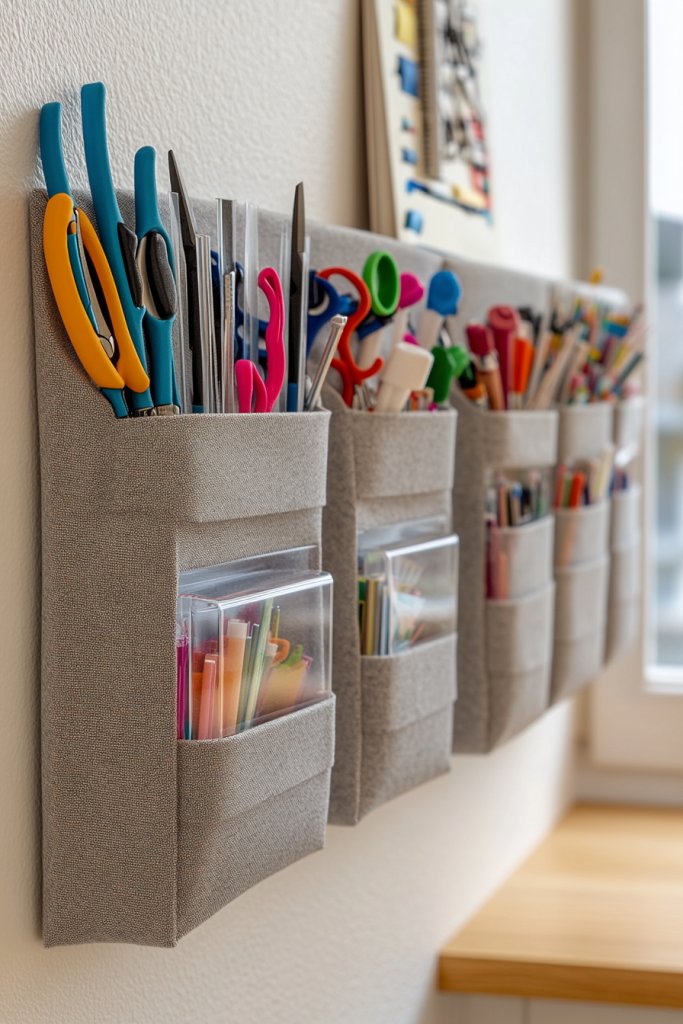
Messy art and craft supplies can turn your creative corner into a chaos zone. You want a way to organize coloring tools, scissors, and craft bits that’s both accessible and tidy.
Recommended Products to replicate this idea
| # | Preview | Product | |
|---|---|---|---|
| 1 |

|
KIMBORA 2 Packs Narrow Over the Door/Wall Shoe Organizer Cruise, Small Hanging Shoe Rack for Closet... | Check Latest Price |
| # | Preview | Product | |
|---|---|---|---|
| 1 |

|
Adhesive Hooks Kitchen Wall Hooks - 24 Packs Heavy Duty 24lb(Max) Nail Free... | Check Latest Price |
Wall-mounted storage pockets are a clever solution that keeps everything visible and within reach. Who says art storage can’t be fun? Picture a series of mesh or fabric pockets hung on the wall, each filled with different art supplies.
They come in bright colors or neutral tones, depending on your decor. Kids can easily grab what they need or put things away quickly.
The pockets create a playful, functional display that encourages organized creativity. It’s a simple way to keep supplies neat and inspiring.
Choose from hanging fabric pouches, mesh pockets, or clear vinyl organizers. Install them at different heights for easy access by children of various ages.
Use themed or color-coded pockets for different supplies, like markers or scissors. Combine with shelves or pegboards for extra storage options.
Seasonal or project-specific pockets keep things fresh and relevant. Select pockets that fit your wall space and style, then mount securely with hooks or nails.
Organize supplies into each pocket based on type or project. Label pockets with tags or printouts for clarity, especially for younger kids.
Encourage children to put supplies back after use, fostering responsibility. Regularly review and refill pockets to maintain order.
Keep the setup simple and accessible. Decorate with stickers, paint, or fabric wraps to match your decor theme.
Let kids decorate or personalize their pockets for ownership. Use themed stickers or labels for special projects or seasons.
Incorporate decorative elements like ribbons or charms for flair. Personal touches make organized art space inviting and fun.
Organized art supplies boost creativity and independence. Kids learn to manage their materials responsibly and take pride in their work.
An inviting, organized space encourages ongoing creativity and skill development. Ready to turn chaos into colorful order?
Conclusion
With a wide range of homeschool room ideas at your fingertips, you’re empowered to transform any space into an inspiring hub for learning. Implement these creative tips to make your homeschool environment more organized, fun, and motivating. Take the first step today and watch your child’s educational journey flourish in a space you love.
Last update on 2025-12-10 / Affiliate links / Images from Amazon Product Advertising API